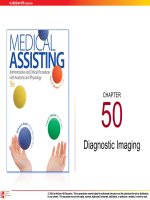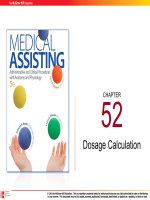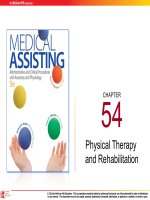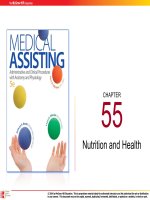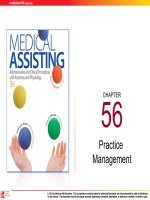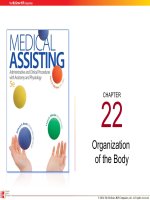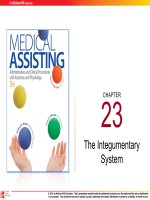Medical assisting Administrative and clinical procedures (5e) Chapter 11
Bạn đang xem bản rút gọn của tài liệu. Xem và tải ngay bản đầy đủ của tài liệu tại đây (772.03 KB, 51 trang )
CHAPTER
11
Medical Records
and Documentation
11-2
Learning Outcomes (cont.)
11.1 Explain the importance of patient medical
records.
11.2 Identify the documents that comprise a
patient medical record.
11.3 Compare SOMR, POMR, SOAP, and
CHEDDAR medical record formats.
11.4 Identify the six Cs of charting, giving an
example of each.
11-3
Learning Outcomes (cont.)
11.5 Describe the need for neatness, timeliness,
accuracy, and professional tone in patient
records.
11.6 Illustrate the correct procedure for correcting
and updating a medical record.
11.7 Describe the steps in responding to a written
request for release of medical records.
11-4
Introduction
• Medical assistants role regarding patient
health records
– Documentation
– Maintenance
• Medical records – critical to patient care
– Evaluation
– Management
– Treatment
11-5
The Importance of Medical Records
• Past medical history and present condition
• Communication tool for healthcare team
• Legal documentation
• Patient and staff education
• Quality control and
research
• Documentation for
billing and coding
11-6
Importance of Patient Records (cont.)
• General information
– Contact information
– Occupation
– Medical history
– Current complaint
– Healthcare needs
– Treatment plan or services provided
– Radiology and laboratory reports
– Response to care
11-7
Legal Guidelines for Patient Records
• Support a malpractice claim
• Support defense for a malpractice claim
• Back up financial records
• Documentation
– Medical care, evaluation and instructions
– Noncompliant patient
11-8
Standards for Records
• Evidence of appropriate care
– Complete
– Accurate
• Everyone who documents in the patient
record has a responsibility to the patient
and physician
11-9
Additional Uses of Patient Records
Patient
Education
• Test results
• Health issues
• Treatment
instructions
Quality of
Treatment
Research
• Peer review
Source of data
• TJC review
• Health-care
analysis and
policy decisions
11-10
Apply Your Knowledge
What is the purpose of documentation in a patient’s
medical record?
ANSWER: Documentation in the medical record
provides evidence of appropriate care. If a
procedure is not documented, it is considered not
done.
11-11
Contents of Patient Medical Records
Patient Registration Form
Date
Patient demographic information
Age, DOB
Address, phone number
SSN
Insurance/financial information
Emergency contact
11-12
Contents of Patient Medical Records (cont.)
• Patient medical history
– Past medical history
– Family medical history
– Social and occupational history
– History of present illness (chief complaint)
11-13
Contents of Patient Medical Records (cont.)
• Physical examination results
– Review of systems
– Form ensures consistency
• Results of laboratory and other tests
• Documents from
Other Sources
11-14
Contents of Patient Medical Records (cont.)
• Doctor’s diagnosis and treatment plan
– Treatment options and plan
– Instructions
– Medication prescribed
– Comments or impressions
• Operative reports, follow-up visits, and
telephone calls
11-15
Contents of Patient Medical Records (cont.)
• Hospital discharge summary forms
• Consent forms
– Verify that the patient understands
procedures, outcomes, and options
– Patient may withdraw consent at any time
11-16
Contents of Patient Medical Records (cont.)
• Correspondence with or about the patient
• Information received by fax – request an
original copy
• Date and initial everything you place in the
chart
11-17
Maintaining Confidentiality
1. The right to notice of privacy practices.
2. The right to limit or request restriction on
their PHI and its use and disclosure.
3. The right to confidential communications.
11-18
Maintaining Confidentiality (cont.)
4. The right to inspect and obtain a copy of
their PHI.
5. The right to request an amendment to
their PHI.
6. The right to know if their PHI has been
disclosed and why.
11-19
Apply Your Knowledge
What section of the patient record contains
information about smoking, alcohol use, and
occupation?
ANSWER: Information about smoking, alcohol use,
and occupation is part of the patient’s past medical
history.
11-20
Types of Medical Records
• Source-Oriented Medical Records
– Information is arranged according to who
supplied the data
– Problems and treatments are on the same
form
– Difficult to track progress of specific events
11-21
Types of Medical Records (cont.)
• Problem-Oriented Medical Records
– Data Base
– Problem List
• Each problem numbered
• Sign vs. symptom
– An Educational, Diagnostic, and Treatment
Plan per each problem
– Progress Notes
11-22
Types of Medical Records (cont.)
• SOAP documentation
– Orderly series of steps for dealing with any
medical case
– Lists the following
• Patient symptoms
• Diagnosis
• Suggested treatment
11-23
SOAP Documentation
Information the patient tells you
ubjective data
bjective data
ssessment
lan
What the physician observes during
the examination
The impression of the patient’s
problem that leads to diagnosis
The treatment plan to correct the
illness or problem
11-24
CHEDDAR Format
• Expands on SOAP format
C
Chief complaint, presenting problems, subjective
statements
H
History – social and physical history
D
Examination
11-25
CHEDDAR Format
• Expands on SOAP format
D
Drugs and dosage
A
Assessment of diagnostic process and diagnosis
R
Return visit information or referral
